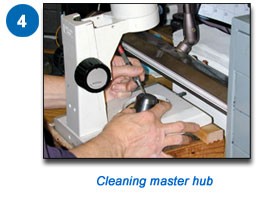Each time Congress authorizes a new coin or medal, an artist sketches out ideas for the design. While the designer may be a U.S. Mint sculptor-engraver (who may use public domain or licensed copyright-protected sources) or a private-sector artist, it is important to note that the creator of the design does not necessarily sculpt the model that will be used to make a coinage die. Generally, that step is performed by U.S. Mint sculptor-engravers. It is not uncommon for our sculptor-engravers to be tasked with both the design and modeling of U.S. coins and medals.

|
After one design has been approved, the U.S. Mint sculptor-engraver
sculpts a clay model. This model is usually three to twelve times the size
of the finished coin or medal.
|

|
Plaster is poured over the clay model, forming a negative plaster model.
Then the lettering is cut into the plaster in reverse. Several plaster
models are refined to make the best possible model. After the model is
approved, a negative rubber mold is made and epoxy is poured into it to
create an extremely durable model.
|

|
The epoxy model is mounted on a machine called a transfer-engraver. At
one end, a stylus traces the large epoxy model. In between, a ratio bar is
set to transfer the design to a smaller size. At the other end of the
machine, a carbide tool cuts the reduced design into a steel blank, making a
positive replica called a master hub.
|

|
Finally, any imperfections that occurred during the transfer process are
removed by the U.S. Mint sculptor-engravers.
|
Additional information on how coins are made.
|